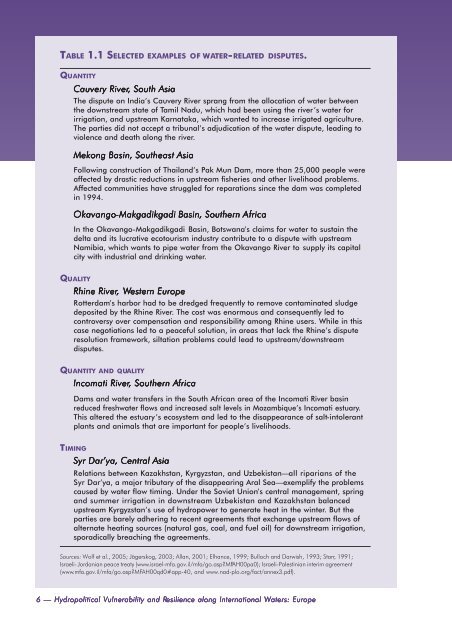Europe - UNEP
Europe - UNEP
Europe - UNEP
You also want an ePaper? Increase the reach of your titles
YUMPU automatically turns print PDFs into web optimized ePapers that Google loves.
TABLE 1.1 SELECTED EXAMPLES OF WATER-RELATED DISPUTES.<br />
QUANTITY<br />
Cauvery River, , South Asia<br />
The dispute on India’s Cauvery River sprang from the allocation of water between<br />
the downstream state of Tamil Nadu, which had been using the river’s water for<br />
irrigation, and upstream Karnataka, which wanted to increase irrigated agriculture.<br />
The parties did not accept a tribunal’s adjudication of the water dispute, leading to<br />
violence and death along the river.<br />
Mekong Basin, Southeast Asia<br />
Following construction of Thailand’s Pak Mun Dam, more than 25,000 people were<br />
affected by drastic reductions in upstream fisheries and other livelihood problems.<br />
Affected communities have struggled for reparations since the dam was completed<br />
in 1994.<br />
Okavango-Makgadikgadi<br />
Basin, Southern Africa<br />
In the Okavango-Makgadikgadi Basin, Botswana’s claims for water to sustain the<br />
delta and its lucrative ecotourism industry contribute to a dispute with upstream<br />
Namibia, which wants to pipe water from the Okavango River to supply its capital<br />
city with industrial and drinking water.<br />
QUALITY<br />
Rhine River, , Western <strong>Europe</strong><br />
Rotterdam’s harbor had to be dredged frequently to remove contaminated sludge<br />
deposited by the Rhine River. The cost was enormous and consequently led to<br />
controversy over compensation and responsibility among Rhine users. While in this<br />
case negotiations led to a peaceful solution, in areas that lack the Rhine’s dispute<br />
resolution framework, siltation problems could lead to upstream/downstream<br />
disputes.<br />
QUANTITY AND QUALITY<br />
Incomati River, , Southern Africa<br />
Dams and water transfers in the South African area of the Incomati River basin<br />
reduced freshwater flows and increased salt levels in Mozambique’s Incomati estuary.<br />
This altered the estuary’s ecosystem and led to the disappearance of salt-intolerant<br />
plants and animals that are important for people’s livelihoods.<br />
TIMING<br />
Syr Dar’ya, Central Asia<br />
Relations between Kazakhstan, Kyrgyzstan, and Uzbekistan—all riparians of the<br />
Syr Dar’ya, a major tributary of the disappearing Aral Sea—exemplify the problems<br />
caused by water flow timing. Under the Soviet Union’s central management, spring<br />
and summer irrigation in downstream Uzbekistan and Kazakhstan balanced<br />
upstream Kyrgyzstan’s use of hydropower to generate heat in the winter. But the<br />
parties are barely adhering to recent agreements that exchange upstream flows of<br />
alternate heating sources (natural gas, coal, and fuel oil) for downstream irrigation,<br />
sporadically breaching the agreements.<br />
Sources: Wolf et al., 2005; Jägerskog, 2003; Allan, 2001; Elhance, 1999; Bulloch and Darwish, 1993; Starr, 1991;<br />
Israeli- Jordanian peace treaty (www.israel-mfa.gov.il/mfa/go.asp?MFAH00pa0); Israeli-Palestinian interim agreement<br />
(www.mfa.gov.il/mfa/go.asp?MFAH00qd0#app-40, and www.nad-plo.org/fact/annex3.pdf).<br />
6 — Hydropolitical Vulnerability and Resilience along International Waters: <strong>Europe</strong>
















